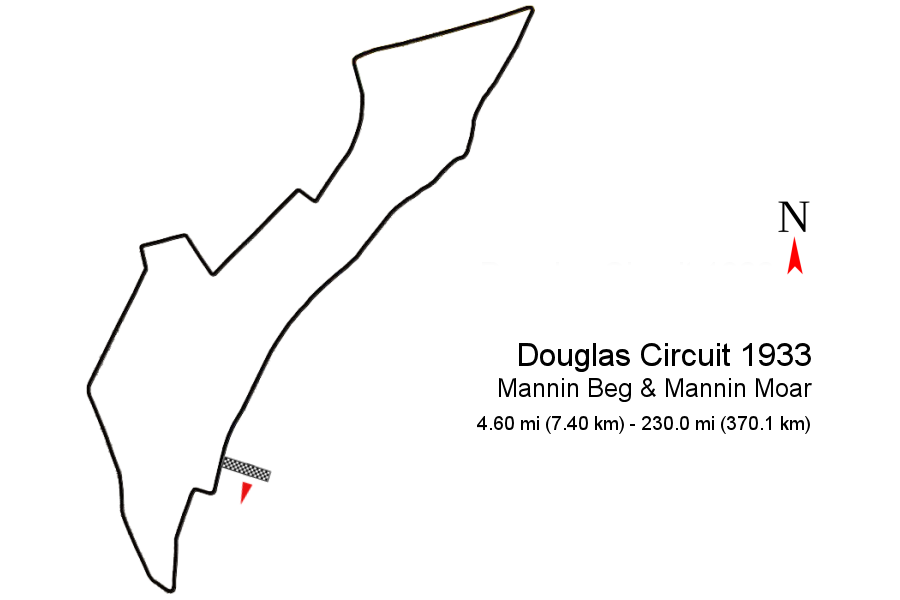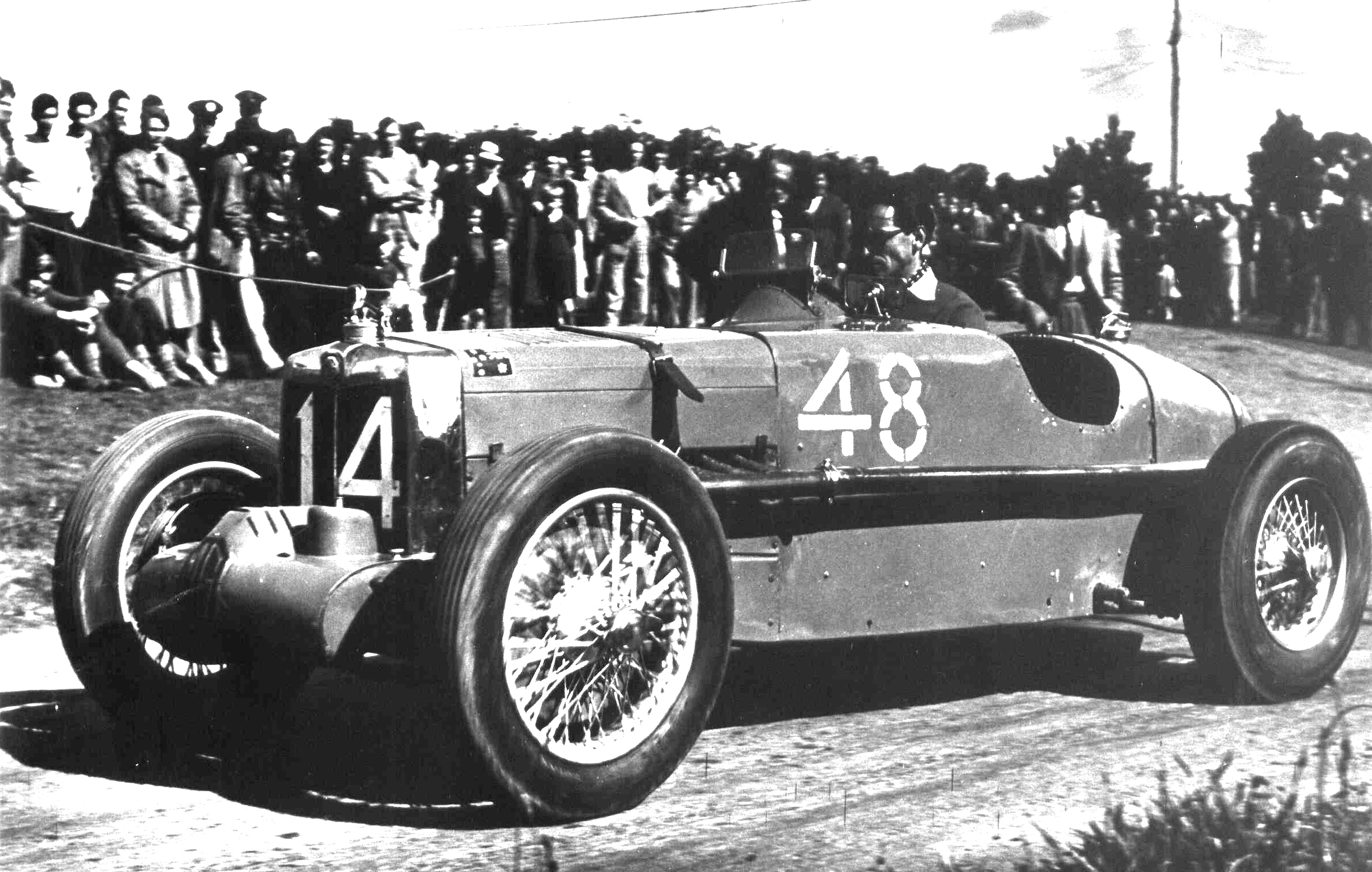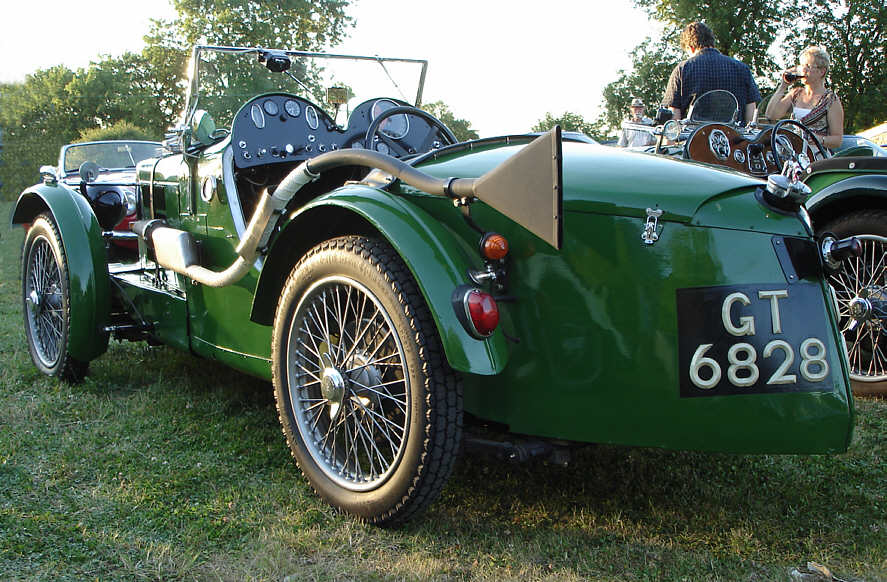|
Magic Midget
The Magic Midgets were a number of record-breaking 750cc "midget" MG cars of the 1930s. They were most notably, but not always, driven by George Eyston. Although of small engine capacity, they were frequently supercharged to increase performance. Never as fast as the aero-engined land speed record behemoths driven by the likes of Henry Segrave, they set numerous speed records for their engine capacity class. EX120 In 1929, MG were attempting to develop their M-type Midget for racing. The rear axle leaf springs were mounted in sliding trunnions at the rear end, rather than the more usual shackles. The improved axle location encouraged good handling, which compensated when racing for the 750cc engine's low power output. Captain George Eyston and Ernest Eldridge saw this chassis under development and decided that it could form the basis for a speed record breaker. Fitted with larger brakes from a Mark II, a four speed gearbox and streamlined bodywork, it became the EX120. On 3 ... [...More Info...] [...Related Items...] OR: [Wikipedia] [Google] [Baidu] |
MG Cars
MG is a British automotive marque founded by Cecil Kimber in the 1920s, and M.G. Car Company Limited was the British sports car manufacturer that made the marque famous. Best known for its open two-seater sports cars, MG also produced saloons and coupés, with engines up to three litres in size and 3.5L in the case of the MGB GT V8. The marque is now owned by Chinese state-owned automaker SAIC Motor Corporation Limited. MG cars had their roots in a 1920s sales promotion sideline of Morris Garages, a retail sales and service centre in Oxford belonging to William Morris. The business's manager, Cecil Kimber, modified standard production Morris Oxfords and added ''MG Super Sports'' to the plate at the nose of the car. A separate M.G. Car Company Limited was incorporated in July 1930. It remained Morris's personal property until 1 July 1935, when he sold it to his holding company, Morris Motors Limited. MG underwent many changes in ownership over the years. Morris's Nuffield O ... [...More Info...] [...Related Items...] OR: [Wikipedia] [Google] [Baidu] |
Mannin Moar
The Mannin Moar was a non-championship Grand Prix held in Douglas, Isle of Man, Great Britain in 1933, 1934 and 1935. The most successful driver was Brian Lewis, having won all three races. Background Rules and restrictions When the R.A.C. wanted to organise a race on a street circuit, because of the popular Monaco Grand Prix, they found that it was illegal to close public roads for racing in the British mainland. However, the Isle of Man had its own laws, so a racing circuit was designed on the streets of Douglas. Two races were organised, Mannin Beg (''English: Small Man'') for non-supercharged voiturettes with engines smaller than 1500 cc on 12 July 1933 and Mannin Moar (''English: Great Man'') for cars with engines over 1500cc and supercharged voiturettes on 14 July 1933. Riding mechanics were mandatory for all cars. This was possibly the last time this rule was used in Grand Prix motor racing. The purpose of this rule was that the mechanics could signal to the flag ma ... [...More Info...] [...Related Items...] OR: [Wikipedia] [Google] [Baidu] |
MG Experimental And Prototype Models
MG, Mg, or mg and variants may refer to: Organizations * MG Cars, an automotive marque of the now defunct MG Car Company * MG Motor, a present-day car manufacturing company *MG JW Automobile, a Pakistani automobile manufacturer * Champion Air (IATA code) * Matematička gimnazija, a school in Belgrade * Monte Generoso railway Arts and entertainment * MG, a character in ''The Perhapanauts'' comics * ''Match Game'', a television game show * Magilla Gorilla, a cartoon character Music * '' Main gauche'', "left hand" in piano playing * ''MG'' (Martin Gore album) * The M.G.'s, from the band Booker T. & the M.G.'s * ''The MG's'' (album), an album by the M.G.'s * MG Select, a house duo music production including George Jackson * M:G, real name Maribel Gonzalez, dance music singer Military * Machine gun (MG-), prefix for model designations, for example, "MG42" * Major general, a military rank * Medal for Gallantry, a military decoration Places * Madagascar (ISO 3166-1 country code MG ... [...More Info...] [...Related Items...] OR: [Wikipedia] [Google] [Baidu] |
MG MGA
The MGA is a sports car that was produced by MG from 1955 until 1962. The MGA replaced the MG TF 1500 Midget and represented a complete styling break from MG's earlier sports cars. Announced on 26 September 1955 the car was officially launched at the Frankfurt Motor Show. A total of 101,081 units were marketed through the end of production in July 1962, the vast majority of which were exported. 5869 cars were sold on the home market, and the MGA was replaced by the MGB. Design The MGA design dates back to 1951, when MG designer Syd Enever created a streamlined body for George Philips' TD Le Mans car. The new bodywork traded the MG TF's articulated fenders and running board for ponton styling, with a single styled envelope fully enclosing the width and uninterrupted length of a car. The TF featured a high driver seating position. A new chassis was designed with the side members further apart and the floor attached to the bottom rather than the top of the frame sections. A p ... [...More Info...] [...Related Items...] OR: [Wikipedia] [Google] [Baidu] |
Reid Railton
Reid A. Railton (1895–1977) was a British automotive engineer, and designer of land and water speed record vehicles. Biography Reid Antony Railton was the son of a Manchester stockbroker: Charles Withingon Railton and his wife Charlotte Elizabeth (née Sharman), Reid was born in Chorley, Alderley Edge, Cheshire and was christened on 13 August 1895 at the local parish church. He was educated at Rugby School and Manchester University. He joined Leyland Motors in 1917 where he worked with J.G. Parry-Thomas on the Leyland Eight luxury car. He left in 1922 to set up the Arab Motor Company where he was chief designer. Only about twelve cars were built, of which two low-chassis cars survive. One is in the Isle of Man and the other one (chassis number 6, engine number 10, registration UW 2) is now in Austria having been rebuilt and rebodied by David Barker in the early 1990s. In 1927, on the death of his friend Parry-Thomas, Railton closed the Arab factory and moved to Brooklands ... [...More Info...] [...Related Items...] OR: [Wikipedia] [Google] [Baidu] |
Goldie Gardner
Lieutenant-Colonel Alfred Thomas Goldie Gardner (31 May 1890 – 25 August 1958) was an English racing car driver who was awarded the BRDC Gold Star three times. In 1939 he was the first to exceed 200 mph in a light car. Early life Gardner who was known as Goldie Gardner (Goldie was his mother's maiden name) was born in Woodford Green, Essex, and was educated at Pelham House, School, Sandgate, Kent. and Uppingham School."Lt.-Col. A. T. G. Gardner." Times ondon, England28 August 1958: 10. The Times Digital Archive. Web. 1 May 2013. In 1910 he embarked from England to Colombo, Ceylon, to take up a 3-year business appointment. Upon completion of his Ceylon contract he gained a new appointment in Katha, Burma, but it was cut short by a bad attack of typhoid fever with malaria and he was sent back to England on six months' sick leave. First world war During his convalescence in 1914, the First World War started. He enlisted in September of that year and was granted a commiss ... [...More Info...] [...Related Items...] OR: [Wikipedia] [Google] [Baidu] |
Autocar (magazine)
''Autocar'' (originally ''The Autocar'') is a weekly British automobile magazine published by the Haymarket Media Group. It was first published in 1895 and refers to itself as "the world's oldest car magazine". There are now several international editions, including for China, India, New Zealand, and South Africa. History The publication was launched as ''The Autocar'' by Iliffe and Son Ltd. "in the interests of the mechanically propelled road carriage" on 2 November 1895 when, it is believed, there were only six or seven cars in the United Kingdom. L. J. K. Setright suggests that the magazine was set up by Henry Sturmey as an organ of propaganda for Harry J. Lawson, founder of the Daimler Company and a journalist on the magazine in its early days. Henry Sturmey stood down as editor of ''The Autocar'' magazine and left the company in 1901. ''Autocar'' claims to have invented the road test in 1928 when it analysed the Austin 7 Gordon England Sunshine Saloon. ''Aut ... [...More Info...] [...Related Items...] OR: [Wikipedia] [Google] [Baidu] |
Pendine Sands
Pendine Sands ( cy, Traeth Pentywyn) is a beach on the shores of Carmarthen Bay on the south coast of Wales. It stretches west to east from Gilman Point to Laugharne Sands. The village of Pendine ( cy, Pentywyn, link=no) is close to the western end of the beach. In the early 1900s the sands were used as a venue for car and motor cycle races. From 1922 the annual Welsh TT motor cycle event was held here. The firm, flat surface of the beach created a race track that was straighter and smoother than many major roads of the time. '' Motor Cycle'' magazine described the sands as "the finest natural speedway imaginable". Classic record attempts In the 1920s it became clear that roads and race tracks were no longer adequate venues for attempts on the world land speed record. As record-breaking speeds approached 150 mph (240 km/h), the requirements for acceleration to top speed before the measured mile and safe braking distance afterwards meant that a smooth, flat, straight ... [...More Info...] [...Related Items...] OR: [Wikipedia] [Google] [Baidu] |
Magic Midget (small)
The Magic Midgets were a number of record-breaking 750cc "midget" MG Cars, MG cars of the 1930s. They were most notably, but not always, driven by George Eyston. Although of small engine capacity, they were frequently supercharged to increase performance. Never as fast as the aero-engined land speed record behemoths driven by the likes of Henry Segrave, they set numerous speed records for their engine capacity class. EX120 In 1929, MG were attempting to develop their MG M-type, M-type Midget for racing. The rear axle leaf springs were mounted in sliding trunnions at the rear end, rather than the more usual shackles. The improved axle location encouraged good handling, which compensated when racing for the 750cc engine's low power output. George Eyston, Captain George Eyston and Ernest Eldridge saw this chassis under development and decided that it could form the basis for a speed record breaker. Fitted with larger brakes from a MG 18/80#Mark II, Mark II, a four speed gearbox an ... [...More Info...] [...Related Items...] OR: [Wikipedia] [Google] [Baidu] |
MG K-type
The MG K-type Magnette is a motor car produced in the United Kingdom by MG from October 1932 to 1934. Launched at the 1932 London Motor Show, the K-Type replaced the F-Type Magna but having at first a slightly smaller capacity engine it took the name Magnette. The chassis was similar to the Magna but strengthened and had the track increased by 6 inches (150 mm) to 48 inches (1200 mm) and was available in two lengths with a wheelbase of either 94 inches (2388 mm) or 108 inches (2743 mm). The steering was modified with a patented divided track rod which was claimed to reduce kick back at the steering wheel. The brakes were cable operated with 13-inch (330 mm) drums made of " Elektron", a light magnesium alloy, with shrunk in steel liners. Suspension by half-elliptic springs and Hartford friction shock absorbers all round with rigid front and rear axles. Wire wheels with 4.75 x 19 tyres and centre lock fixing were used. The engines wer ... [...More Info...] [...Related Items...] OR: [Wikipedia] [Google] [Baidu] |
MG C-type
The MG C-type is a sports car that was produced by MG from 1931 to 1932. It was designed for competition use and based on the M-Type Midget. A special car, EX120 had been developed from the M-Type for George Eyston to make an attempt on the 750 cc class 24-hour record at Autodrome de Montlhéry in France. The attempt was successful and a series of replica cars were made which became the C-Type. The car used a tuned short-stroke (73 mm) version of the bevel gear driven overhead camshaft engine from the 1928 Morris Minor and Wolseley 10 with a single SU carburettor and a new crankshaft producing at 6400 rpm. It could from 1932 be had with the crossflow head to be seen later on the MG J-type and a Powerplus supercharger version was also available with at 6500 rpm. Drive was to the rear wheels through a four-speed non- synchromesh gearbox. The chassis was new and took the form of a ladder frame with tubular cross members and passed under the rear axle. The suspension use ... [...More Info...] [...Related Items...] OR: [Wikipedia] [Google] [Baidu] |






